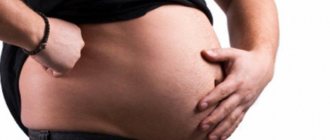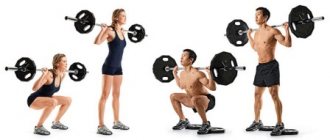Drying for men, as well as for girls, has its own characteristics, which we will try to talk about in this article.
Body drying for men is carried out with the main goal - to burn excess fat and emphasize the relief of a trained body. But the results may vary.
- Ectomorphs who have a naturally thin physique and a minimal percentage of fat “dry” better and faster than others
- And also mesomorphs with pronounced muscles and a moderate layer of fat;
- The hardest thing is for endomorphs - massive athletes with a large percentage of fat.
The first type dries effectively, even without resorting to intense aerobic exercise. It is enough to train in high numbers of repetitions with relatively light weights. Plus a special drying diet for men - and the job is done! With the second, the situation is generally similar.
But it is more difficult for endomorphs to achieve muscle definition. If you consider yourself to be the third type, get ready for the most thorny and difficult path - the slightest deviations from your diet or training program can affect the achievement of results. Cardio exercises in this case are also necessary (unlike the first two types).
Carbohydrates during drying
Before you learn how to count carbohydrates during drying and how much of them should be in the daily diet, you should understand what value they represent for an athlete. Carbohydrates are an important organic substance that increases endurance and energy. In addition, carbohydrates are necessary for recovery and proper muscle building. Absolutely minimizing the amount of daily carbohydrates is not recommended.
Also, every athlete should know that carbohydrates can be complex and simple, in other words, “good” and “bad.” Simple carbohydrates are not beneficial for the human body; they are processed quite quickly and turn into fat. For this reason, simple carbohydrates should be excluded from the diet.
Proper nutrition for drying the body: how to successfully burn excess fat!
The bottom line is that the first thing you need to do is cut back on the amount of carbohydrates in your diet if you are going on a body-drying diet. I'll point out a few tips to help you do this correctly and effectively.

You must have heard: “Abs are made in the kitchen,” and it is true that a proper nutrition program is an important tool for achieving six-pack abs. Regardless of the type of training, you will never see results if your diet is not properly planned.
There are several different theories about the best way to lose body fat, but the best methods have one thing in common. The main position is that you need to cut down on the amount of carbohydrates you consume. The main reason is that carbohydrates are the main source of energy.
When there are a lot of carbohydrates, your body does not need to turn to internal fat deposits to take energy, so the deposits will remain in the same volume. When you force the body to turn to these sources, you see fat decrease. So how does this happen?
Carbohydrates and training
Each athlete has his own point of view in relation to carbohydrates. Some adhere to the tactic that during drying, carbohydrates should be minimized or completely abandoned. Even if you have an identical point of view, you will still have to consume carbohydrates, at least before and after intense physical activity. This is due to the fact that they increase endurance and add energy, that is, without them you will not be able to complete the workout and soon your strength will run out. If you have any suspicions about this, try training at least once on an empty stomach and draw your own conclusions.
After your workout, carbohydrates are no less beneficial. In order for muscles to recover and strengthen, they need a sufficient amount of insulin in the blood, which increases due to the consumption of polysaccharides (complex carbohydrates).
How many carbohydrates should you eat when cutting?
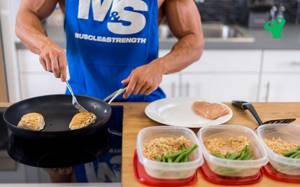
To achieve the desired result, drying meals must be formulated by a specialist. The diet is calculated individually, depending on the initial weight and other characteristics of the body. Order an individual nutrition plan.
On average, carbohydrates should take up about 40% of the daily diet. We should not forget about vegetable fats, which in no case should be completely excluded from the menu. About 10% daily consumption of vegetable fats is the best option. When cutting, only complex carbohydrates are allowed, which take longer to digest, saturate the body with energy and increase endurance. On your way to a ripped body, don't forget to eat protein. You need at least 1.5-2 grams of protein per kilogram of weight, otherwise muscle mass will suffer.
Proper drying: how to safely reduce the amount of carbohydrates?
The main reduction in calorie content during drying should be achieved by eliminating simple carbohydrates and fats of animal origin. You need to reduce your caloric intake gradually; for starters, it is enough to reduce it by 10%. After the innovation, wait a week and analyze the situation. If doing workouts does not bring discomfort in the form of fatigue and lack of energy, and the weight on the scale does not change, you can cut calories by another 10%.
Don't forget about proper training. While cutting, excessive cardio exercise is not recommended, which, in addition to weight, can reduce muscle mass. For this reason, the basis of training is anaerobic exercise, which promotes fat burning and does not have a negative effect on muscle mass. If you are used to running every morning, replace the habit with regular walking. This way you will start the fat burning process without affecting the quality of your muscles.
It is important! For men and women, training programs and their intensity are different. To clarify the optimal level of physical activity, consult a specialist.
What foods contain complex carbohydrates?
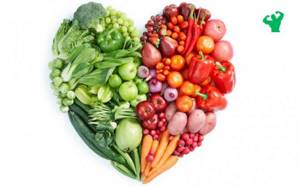
As mentioned above, complex carbohydrates must be present during drying. They are found in many foods: vegetables, fruits, cereals. Nutritionists say that foods need to be chosen correctly to prevent the deposition of fat reserves.
- Vegetables. To avoid problems with the gastrointestinal tract, you need to choose slow carbohydrates with a high fiber content. These include cucumbers, potatoes, pumpkin, and zucchini.
- Fruits. When choosing them, you should be careful and choose those that contain the least amount of sugars. Preference should be given to apples, pears and pomegranates. Occasionally you can eat black currants, figs and blackberries.
- Cereals and legumes. This category of food products is characterized by a high content of beneficial vitamins and microelements. When drying, it is recommended to eat buckwheat, rye, oats, and brown wild rice.
- Porridge. Almost all cereals are complex carbohydrates, with the exception of semolina. When drying, you can cook porridge with water or skim milk.
- Pasta. You can eat it 3 times a week, provided that the product is made from wholemeal flour.
If you have an avid sweet tooth and it is very difficult to give up sweets, occasionally for breakfast you can eat a piece of dark chocolate or homemade jelly based on berries or fruits.
Reference! You can calculate proteins, fats and carbohydrates for cutting using an online calculator.
How to calculate body drying taking into account physical activity?

Everyone knows that the more you exercise, the more calories you burn. But we need an accurate calculation of calories for drying the body, so we must also take into account physical activity. Be honest with yourself and first determine your level of physical activity.
For those who lead a sedentary lifestyle, the BUM value should be multiplied by 1.2. If you are slightly active, then multiply BOOM by 1.375. If you have a moderately active lifestyle (work out 3-5 times a week), multiply by 1.55. If you are very active and enjoy playing vigorous sports, then multiply BOOM by 1.725.
Now we can know how many calories the body needs during physical activity. For example, taking the previous calculated values (2147.9) assuming a very active lifestyle, we get the following: 2147.9 * 1.725 = 3705.1 - this is the daily calorie intake.
General recommendations
- Never skip breakfast. The first meal stores energy for the whole day. Breakfast should consist of protein, complex carbohydrates and vegetable fats.
- An important rule is to consume carbohydrates exclusively in the first half of the day.
- Don't overeat before bed. The best option is to eat 2-3 hours before bedtime.
- Drink enough clean water, at least 2.5 liters per day.
- Be sure to take in enough protein to avoid losing muscle mass in addition to burning fat.
It is important! Carbonated drinks, various sauces. Fatty, smoked and salty foods are prohibited during drying.
Proper planning of diet and nutritional supplements
When is the best time to eat different foods?
Choosing the right time to eat different types of foods is a key point in cutting diets. You must know which foods to eat and when. Following this protocol will help you quickly get a visible effect on your body and overall well-being.
The first thing to think about is that you should eat at least 5-6 times a day. This will help keep your metabolic rate high, allowing you to burn more calories throughout the day, while also signaling to your body that extra energy is needed.
Leaving 3-4 hours between meals, set your first meal immediately after waking up and your last one an hour before bed.
For example, meals at 7:00, 10:00, 13:00, 16:00, 19:00 and 22:00 would be good options. Of course, this may not fit your usual needs, but try to arrange it in a similar order.
But you can also do 3 meals a day if you don’t like to eat often and prefer to fill yourself up in one meal rather than go around constantly hungry. The trick is to consume the planned number of calories per day and not an ounce more.
And here the strategy for some is to eat often but in small portions, while for others it is better to eat well once and take a longer break between meals. But in both the first and second cases, if 1600 calories are planned for the day, then 1600 calories should be eaten, without additional snacks.
Hydration of the body
The only drinks you should drink while dieting are water, green tea and, if necessary, black coffee. Other drinks contain extra calories or have artificial sweeteners and other additives that can stop you from drying out.
Water contains no calories, quenches your thirst, and is basically all you need to drink. If you are one of those who find it difficult to drink a lot of water, fill a one and a half liter bottle of water and try to drink it throughout the day. Also start your morning with two glasses of water.
Amount of carbohydrate intake
The next point in the plan is the amount of carbohydrates consumed per day. First and foremost, you need to make sure you have sources of complex carbohydrates that digest slowly and gradually enter the bloodstream, reducing the likelihood of fat accumulation.
They also provide a large amount of nutrients and satisfy hunger. Good sources of carbohydrates to eat while cutting:
- Oatmeal
- Sweet potato
- Brown rice
- Durum wheat pasta
- Buckwheat
Fruits are okay for some people during drying, while others should avoid them. If you're going to include fruit in your diet, it's best to eat it before and after your workouts, so you'll need carbohydrates as an energy source for your workout and recovery afterwards. And, of course, you should get the most carbohydrates during drying from vegetables.
This group of products will provide the necessary fiber, which normalizes digestion and satisfies hunger due to the large volume of food with a low calorie content. Peas and corn are two vegetables known for being full of calories and carbohydrates.
Sahara
One of the best ways to lose weight is to eat foods with low GI (glycemic index) levels. Conventionally, GI is related to the sugar content of food and how quickly it releases glucose into the body. If you don't exercise and still eat foods high in GI, they will be stored as fat.
Accepting this fact, you should eliminate sweets as well as high GI foods such as white rice, white bread and pasta, and replace them with low GI counterparts such as brown basmati rice, unprocessed grains and fruits, for example. , apples and berries.
Carbohydrate consumption time
Proper timing of carbohydrate intake is very important for cutting diet success. Since carbohydrates are your primary source of energy, you will use all the nutrients they produce. This means eating carbohydrate-containing foods before and immediately after your workout while your body is recovering.
Typically, eating carbohydrates before and after your workout, as well as in the morning, allows you to use the energy you receive throughout the day.
By the evening, it is necessary to reduce the consumption of carbohydrates, or better yet, eliminate them altogether and consume small amounts of them with green vegetables and leafy greens.

Squirrels
The next point is protein consumption and the correct amount of it in the daily diet. While you're dieting, it's important to get enough protein to maintain as much muscle mass as possible, otherwise your body may use your muscles as a source of amino acids for post-workout recovery, which can cause muscle tissue loss.
Pay attention to your protein intake with each meal to regulate your blood sugar and hunger levels. Before bed, eat some casein protein to provide the amino acids needed to repair your body while you sleep. Cottage cheese is good for this.
The best food sources of protein for drying:
- Eggs
- Chicken breast and whole chicken, but without skin
- Lean beef
- Turkey breast
- Almost any fish
- Cottage cheese
- Soybeans
- Protein supplements
Fats
The last macronutrient worth mentioning is fat in your diet. While you think removing fat from your diet is a good idea because you are trying to get rid of excess fat, you are making a grave mistake. There are good and bad fats, but when dieting you need to reduce your intake of all types as fats are an inefficient source of energy compared to carbohydrates and cause fat deposits. But you cannot completely exclude them from the diet. Keep this in mind and aim for 20% or less of your calories from good fats.
The body needs some fat to support immune function, internal organs, good cholesterol levels, and the appearance of skin and hair, so including fat in your diet is a must.
Fats also help regulate insulin levels, making you feel fuller after a meal that contains more than just carbohydrates and protein.
Since you're monitoring your carbohydrate levels throughout the day, it's a good idea to focus on your fat and protein intake in later meals.
For example, while your first three to four meals (breakfast, pre-workout, post-workout, lunch) will provide you with protein and carbohydrates, your next two or three meals (afternoon snack, dinner, and perhaps a second dinner) will give you consume protein and fats.
This will support lipolysis (the process of breaking down fat in the body) in the body throughout the day and also during the night. It will also help you better regulate your insulin and growth hormone levels, which in turn is very important to achieve your fat loss and muscle preservation goals (since growth hormone is released at night and at the same time, consuming carbohydrates reduces its production, so it is very important to eat more protein and fats).
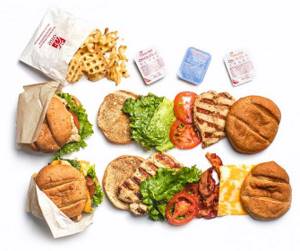
Chitday
The last aspect worth mentioning is the cheat day. Most people who go on diets begin to experience a terrible appetite, especially if they eat low-calorie foods.
In an effort to fight for a beautiful figure, you can allow yourself one cheat day a week and eat whatever you want.
This will help you mentally as you eat and your body can adapt and slow down its metabolism.
If you're looking to lose some weight while losing weight, you might want to have a belly party every few weeks, depending largely on how much weight you want to lose.
A little luxury will not harm you much, but if you start going too far, it can get out of control and you will never achieve success.
When planning a diet, it is important to remember that each body is unique, and what will work successfully for some will not work for others. You have to adapt and watch how your body reacts and what gives the best results.
By following these tips, you can be sure that you will at least start off on the right foot and notice weight loss in no time.








